Analysis of CSL Limited: Environment, Strategy, Capabilities
VerifiedAdded on 2023/01/03
|28
|5603
|33
Report
AI Summary
This report provides a comprehensive ESC (Environment, Strategy, and Capability) gap analysis of CSL Limited, a major biotechnology company based in Australia. The analysis begins with an executive summary and table of contents, followed by an introduction that outlines the aim, scope, and background of CSL Limited, including its operations, leadership, product lines, and key competitors such as Johnson & Johnson and Novartis. The report then delves into a detailed environmental analysis, examining both the remote (political, technological, legal, socio-cultural, demographic, and geographical) and industry environments, including Porter's Five Forces. The strategy section covers CSL's organizational structure, operational strategy, stakeholders, and financial performance, including capital and revenue generation. Next, the report assesses CSL's capabilities, considering purpose, size, price, and performance. The core of the report, the ESC gap analysis, identifies environmental, strategic, and capability gaps. Finally, the report concludes with strategic recommendations for CSL Limited, such as environment-friendly operations, business expansion, and inducing younger senior managers. The report utilizes Porter’s five forces, graphs, and balance scores to support its analysis and recommendations.
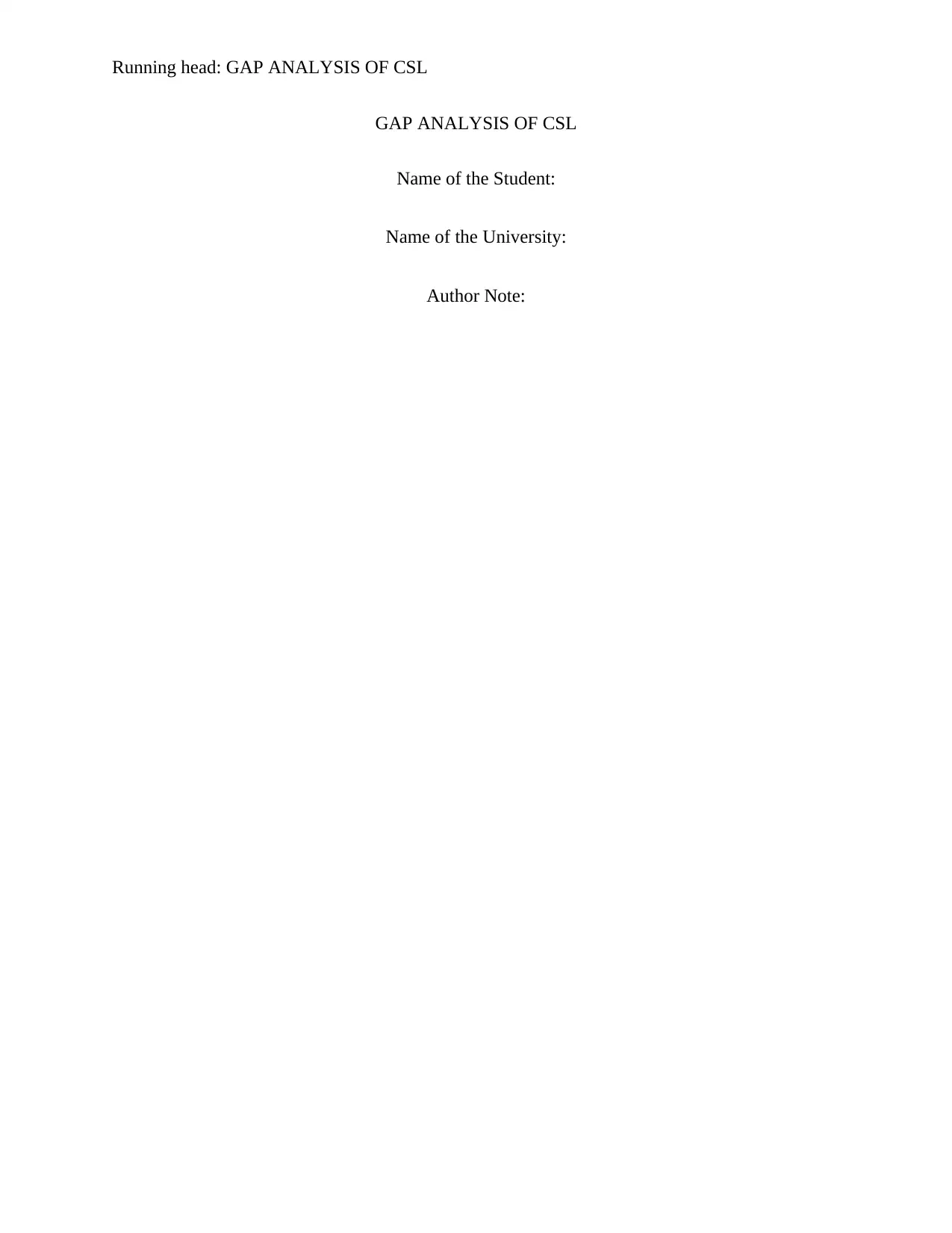
Running head: GAP ANALYSIS OF CSL
GAP ANALYSIS OF CSL
Name of the Student:
Name of the University:
Author Note:
GAP ANALYSIS OF CSL
Name of the Student:
Name of the University:
Author Note:
Paraphrase This Document
Need a fresh take? Get an instant paraphrase of this document with our AI Paraphraser

1
GAP ANALYSIS OF CSL
Executive summary:
It is evident from the report that CSL should restructure its strategies. The analysis shows
that the Australian market is conductive to development and expansion of business organisations.
CSL should align its operations more the emerging markets to gain more competitive advantage.
GAP ANALYSIS OF CSL
Executive summary:
It is evident from the report that CSL should restructure its strategies. The analysis shows
that the Australian market is conductive to development and expansion of business organisations.
CSL should align its operations more the emerging markets to gain more competitive advantage.
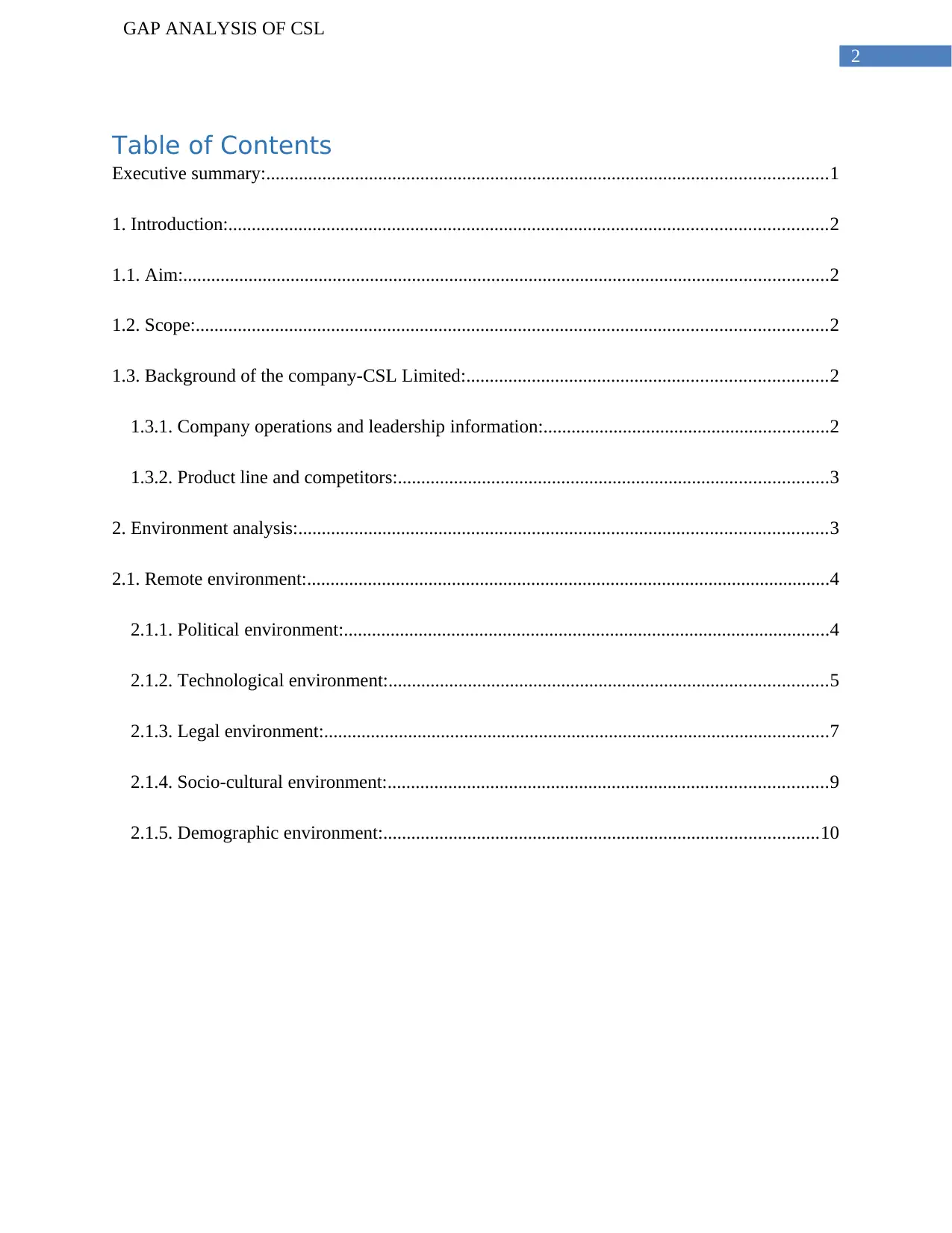
2
GAP ANALYSIS OF CSL
Table of Contents
Executive summary:........................................................................................................................1
1. Introduction:................................................................................................................................2
1.1. Aim:..........................................................................................................................................2
1.2. Scope:.......................................................................................................................................2
1.3. Background of the company-CSL Limited:.............................................................................2
1.3.1. Company operations and leadership information:.............................................................2
1.3.2. Product line and competitors:............................................................................................3
2. Environment analysis:.................................................................................................................3
2.1. Remote environment:................................................................................................................4
2.1.1. Political environment:........................................................................................................4
2.1.2. Technological environment:..............................................................................................5
2.1.3. Legal environment:............................................................................................................7
2.1.4. Socio-cultural environment:..............................................................................................9
2.1.5. Demographic environment:.............................................................................................10
GAP ANALYSIS OF CSL
Table of Contents
Executive summary:........................................................................................................................1
1. Introduction:................................................................................................................................2
1.1. Aim:..........................................................................................................................................2
1.2. Scope:.......................................................................................................................................2
1.3. Background of the company-CSL Limited:.............................................................................2
1.3.1. Company operations and leadership information:.............................................................2
1.3.2. Product line and competitors:............................................................................................3
2. Environment analysis:.................................................................................................................3
2.1. Remote environment:................................................................................................................4
2.1.1. Political environment:........................................................................................................4
2.1.2. Technological environment:..............................................................................................5
2.1.3. Legal environment:............................................................................................................7
2.1.4. Socio-cultural environment:..............................................................................................9
2.1.5. Demographic environment:.............................................................................................10
⊘ This is a preview!⊘
Do you want full access?
Subscribe today to unlock all pages.

Trusted by 1+ million students worldwide

3
GAP ANALYSIS OF CSL
...................................................................................................................................................10
2.1.6. Geographical conditions:.................................................................................................10
2.2. Industry analysis:....................................................................................................................11
2.2.1. Threats of new entrants (very high):................................................................................11
2.2.2. Threats of substitutes (moderate):...................................................................................11
2.2.3. Bargaining power of buyers (moderate to high):.............................................................12
2.2.4. Bargaining power of sellers (high-moderate):.................................................................12
2.2.5. Industry Rivalry (high):...................................................................................................12
3. Strategy:.....................................................................................................................................13
3.1. Overview:...............................................................................................................................13
3.2. Organisational structure:.........................................................................................................13
3.3. Operational strategy:...............................................................................................................13
3.4. Stakeholders:...........................................................................................................................13
3.4.1. Internal stakeholders:.......................................................................................................14
GAP ANALYSIS OF CSL
...................................................................................................................................................10
2.1.6. Geographical conditions:.................................................................................................10
2.2. Industry analysis:....................................................................................................................11
2.2.1. Threats of new entrants (very high):................................................................................11
2.2.2. Threats of substitutes (moderate):...................................................................................11
2.2.3. Bargaining power of buyers (moderate to high):.............................................................12
2.2.4. Bargaining power of sellers (high-moderate):.................................................................12
2.2.5. Industry Rivalry (high):...................................................................................................12
3. Strategy:.....................................................................................................................................13
3.1. Overview:...............................................................................................................................13
3.2. Organisational structure:.........................................................................................................13
3.3. Operational strategy:...............................................................................................................13
3.4. Stakeholders:...........................................................................................................................13
3.4.1. Internal stakeholders:.......................................................................................................14
Paraphrase This Document
Need a fresh take? Get an instant paraphrase of this document with our AI Paraphraser
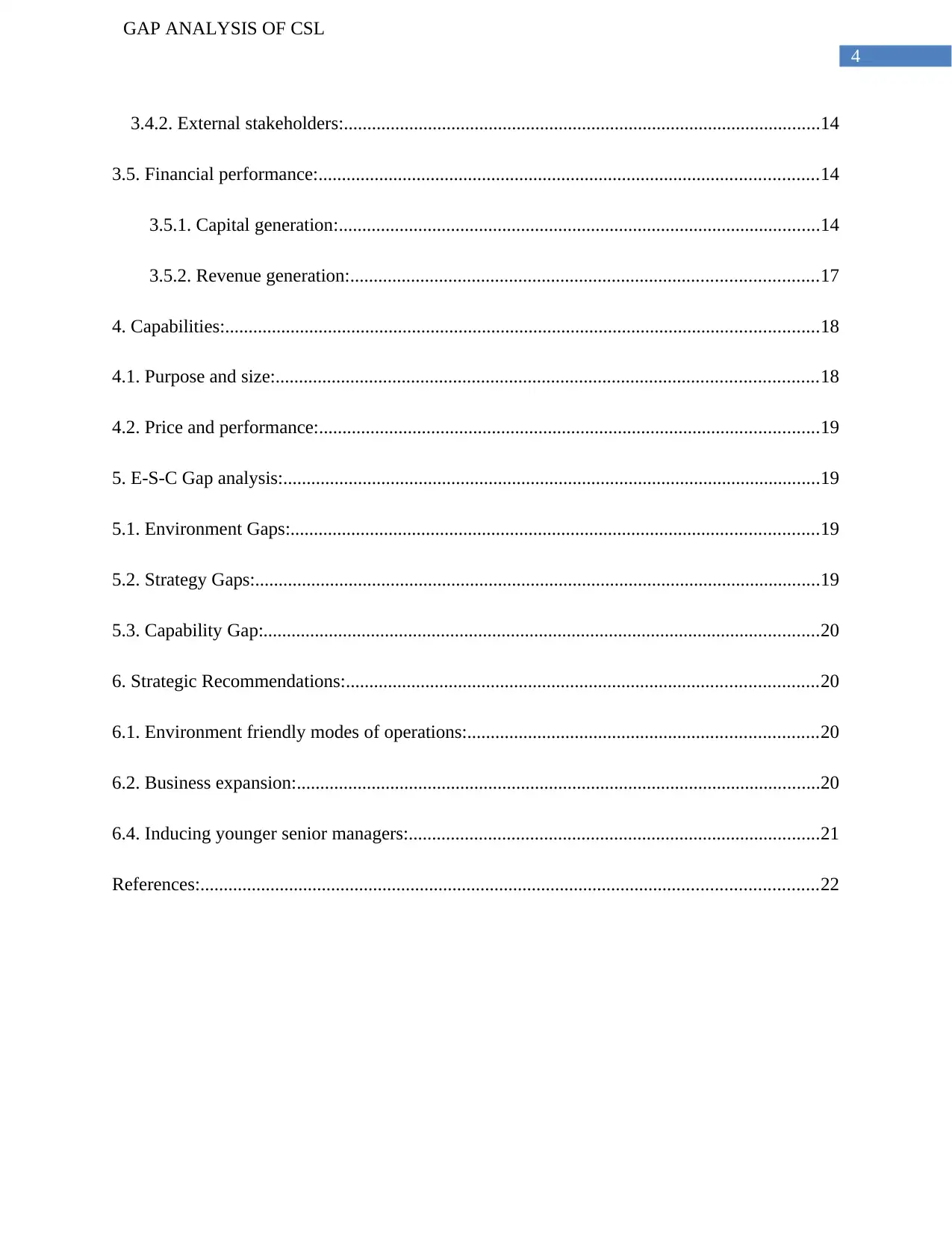
4
GAP ANALYSIS OF CSL
3.4.2. External stakeholders:......................................................................................................14
3.5. Financial performance:...........................................................................................................14
3.5.1. Capital generation:.......................................................................................................14
3.5.2. Revenue generation:....................................................................................................17
4. Capabilities:...............................................................................................................................18
4.1. Purpose and size:....................................................................................................................18
4.2. Price and performance:...........................................................................................................19
5. E-S-C Gap analysis:...................................................................................................................19
5.1. Environment Gaps:.................................................................................................................19
5.2. Strategy Gaps:.........................................................................................................................19
5.3. Capability Gap:.......................................................................................................................20
6. Strategic Recommendations:.....................................................................................................20
6.1. Environment friendly modes of operations:...........................................................................20
6.2. Business expansion:................................................................................................................20
6.4. Inducing younger senior managers:........................................................................................21
References:....................................................................................................................................22
GAP ANALYSIS OF CSL
3.4.2. External stakeholders:......................................................................................................14
3.5. Financial performance:...........................................................................................................14
3.5.1. Capital generation:.......................................................................................................14
3.5.2. Revenue generation:....................................................................................................17
4. Capabilities:...............................................................................................................................18
4.1. Purpose and size:....................................................................................................................18
4.2. Price and performance:...........................................................................................................19
5. E-S-C Gap analysis:...................................................................................................................19
5.1. Environment Gaps:.................................................................................................................19
5.2. Strategy Gaps:.........................................................................................................................19
5.3. Capability Gap:.......................................................................................................................20
6. Strategic Recommendations:.....................................................................................................20
6.1. Environment friendly modes of operations:...........................................................................20
6.2. Business expansion:................................................................................................................20
6.4. Inducing younger senior managers:........................................................................................21
References:....................................................................................................................................22
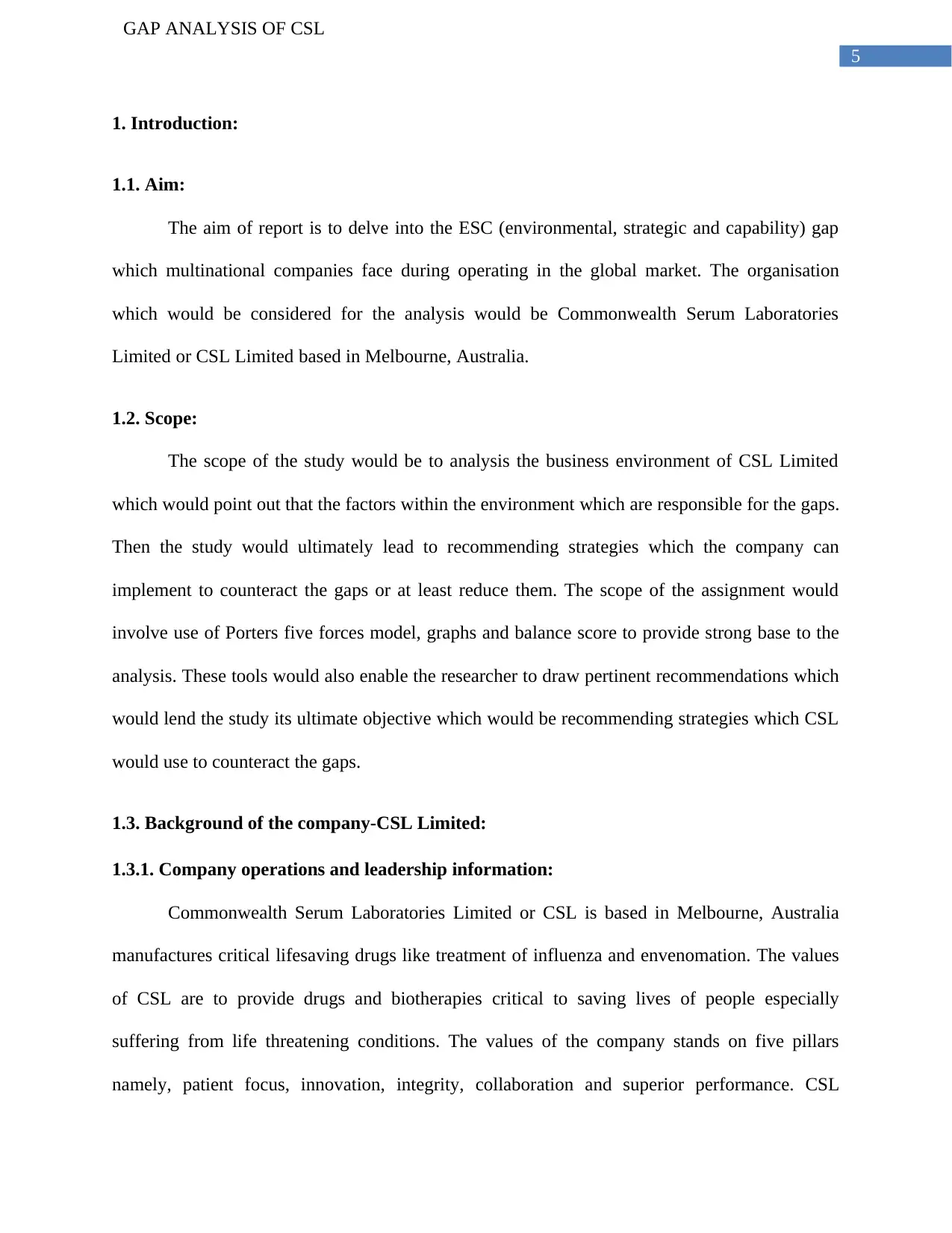
5
GAP ANALYSIS OF CSL
1. Introduction:
1.1. Aim:
The aim of report is to delve into the ESC (environmental, strategic and capability) gap
which multinational companies face during operating in the global market. The organisation
which would be considered for the analysis would be Commonwealth Serum Laboratories
Limited or CSL Limited based in Melbourne, Australia.
1.2. Scope:
The scope of the study would be to analysis the business environment of CSL Limited
which would point out that the factors within the environment which are responsible for the gaps.
Then the study would ultimately lead to recommending strategies which the company can
implement to counteract the gaps or at least reduce them. The scope of the assignment would
involve use of Porters five forces model, graphs and balance score to provide strong base to the
analysis. These tools would also enable the researcher to draw pertinent recommendations which
would lend the study its ultimate objective which would be recommending strategies which CSL
would use to counteract the gaps.
1.3. Background of the company-CSL Limited:
1.3.1. Company operations and leadership information:
Commonwealth Serum Laboratories Limited or CSL is based in Melbourne, Australia
manufactures critical lifesaving drugs like treatment of influenza and envenomation. The values
of CSL are to provide drugs and biotherapies critical to saving lives of people especially
suffering from life threatening conditions. The values of the company stands on five pillars
namely, patient focus, innovation, integrity, collaboration and superior performance. CSL
GAP ANALYSIS OF CSL
1. Introduction:
1.1. Aim:
The aim of report is to delve into the ESC (environmental, strategic and capability) gap
which multinational companies face during operating in the global market. The organisation
which would be considered for the analysis would be Commonwealth Serum Laboratories
Limited or CSL Limited based in Melbourne, Australia.
1.2. Scope:
The scope of the study would be to analysis the business environment of CSL Limited
which would point out that the factors within the environment which are responsible for the gaps.
Then the study would ultimately lead to recommending strategies which the company can
implement to counteract the gaps or at least reduce them. The scope of the assignment would
involve use of Porters five forces model, graphs and balance score to provide strong base to the
analysis. These tools would also enable the researcher to draw pertinent recommendations which
would lend the study its ultimate objective which would be recommending strategies which CSL
would use to counteract the gaps.
1.3. Background of the company-CSL Limited:
1.3.1. Company operations and leadership information:
Commonwealth Serum Laboratories Limited or CSL is based in Melbourne, Australia
manufactures critical lifesaving drugs like treatment of influenza and envenomation. The values
of CSL are to provide drugs and biotherapies critical to saving lives of people especially
suffering from life threatening conditions. The values of the company stands on five pillars
namely, patient focus, innovation, integrity, collaboration and superior performance. CSL
⊘ This is a preview!⊘
Do you want full access?
Subscribe today to unlock all pages.

Trusted by 1+ million students worldwide
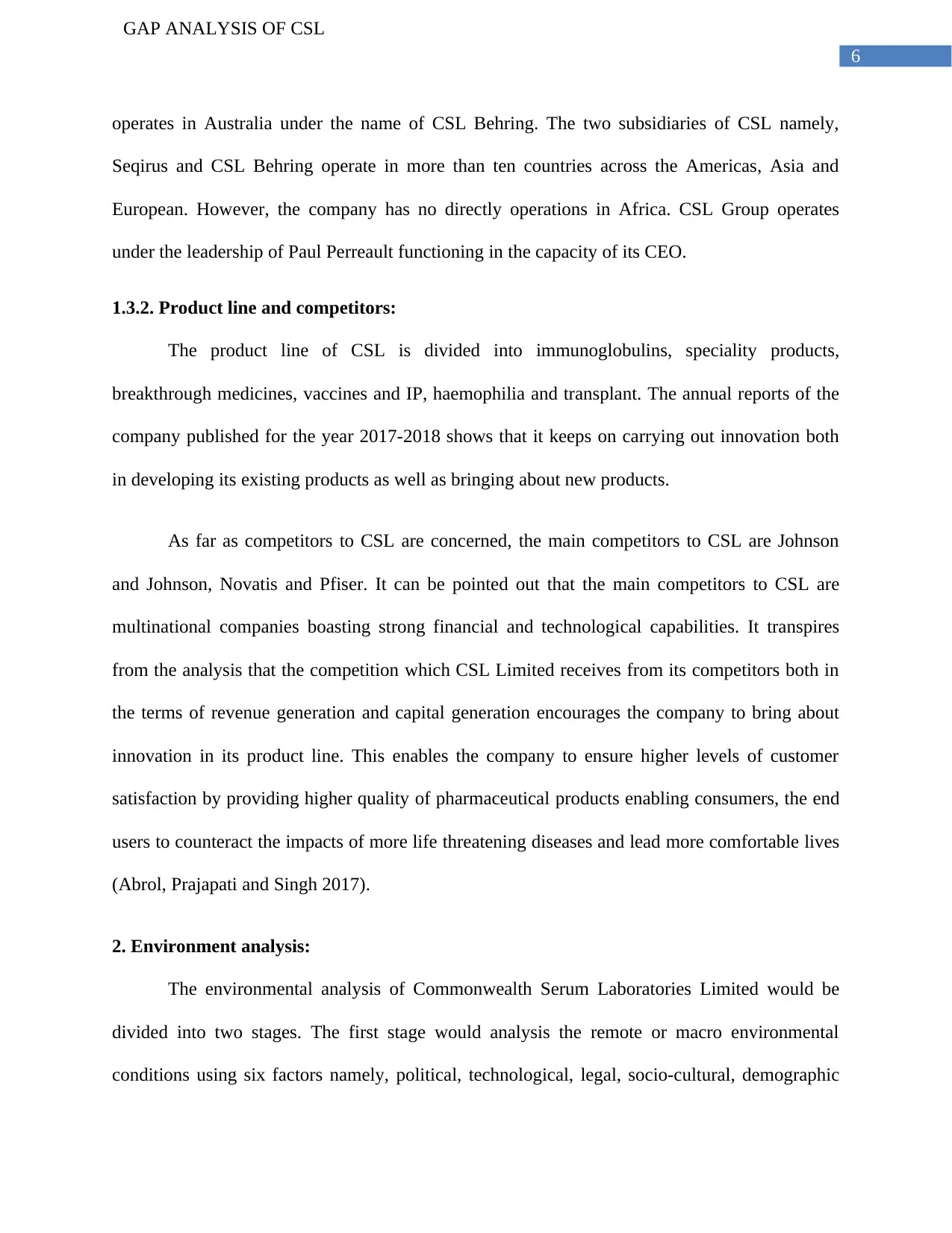
6
GAP ANALYSIS OF CSL
operates in Australia under the name of CSL Behring. The two subsidiaries of CSL namely,
Seqirus and CSL Behring operate in more than ten countries across the Americas, Asia and
European. However, the company has no directly operations in Africa. CSL Group operates
under the leadership of Paul Perreault functioning in the capacity of its CEO.
1.3.2. Product line and competitors:
The product line of CSL is divided into immunoglobulins, speciality products,
breakthrough medicines, vaccines and IP, haemophilia and transplant. The annual reports of the
company published for the year 2017-2018 shows that it keeps on carrying out innovation both
in developing its existing products as well as bringing about new products.
As far as competitors to CSL are concerned, the main competitors to CSL are Johnson
and Johnson, Novatis and Pfiser. It can be pointed out that the main competitors to CSL are
multinational companies boasting strong financial and technological capabilities. It transpires
from the analysis that the competition which CSL Limited receives from its competitors both in
the terms of revenue generation and capital generation encourages the company to bring about
innovation in its product line. This enables the company to ensure higher levels of customer
satisfaction by providing higher quality of pharmaceutical products enabling consumers, the end
users to counteract the impacts of more life threatening diseases and lead more comfortable lives
(Abrol, Prajapati and Singh 2017).
2. Environment analysis:
The environmental analysis of Commonwealth Serum Laboratories Limited would be
divided into two stages. The first stage would analysis the remote or macro environmental
conditions using six factors namely, political, technological, legal, socio-cultural, demographic
GAP ANALYSIS OF CSL
operates in Australia under the name of CSL Behring. The two subsidiaries of CSL namely,
Seqirus and CSL Behring operate in more than ten countries across the Americas, Asia and
European. However, the company has no directly operations in Africa. CSL Group operates
under the leadership of Paul Perreault functioning in the capacity of its CEO.
1.3.2. Product line and competitors:
The product line of CSL is divided into immunoglobulins, speciality products,
breakthrough medicines, vaccines and IP, haemophilia and transplant. The annual reports of the
company published for the year 2017-2018 shows that it keeps on carrying out innovation both
in developing its existing products as well as bringing about new products.
As far as competitors to CSL are concerned, the main competitors to CSL are Johnson
and Johnson, Novatis and Pfiser. It can be pointed out that the main competitors to CSL are
multinational companies boasting strong financial and technological capabilities. It transpires
from the analysis that the competition which CSL Limited receives from its competitors both in
the terms of revenue generation and capital generation encourages the company to bring about
innovation in its product line. This enables the company to ensure higher levels of customer
satisfaction by providing higher quality of pharmaceutical products enabling consumers, the end
users to counteract the impacts of more life threatening diseases and lead more comfortable lives
(Abrol, Prajapati and Singh 2017).
2. Environment analysis:
The environmental analysis of Commonwealth Serum Laboratories Limited would be
divided into two stages. The first stage would analysis the remote or macro environmental
conditions using six factors namely, political, technological, legal, socio-cultural, demographic
Paraphrase This Document
Need a fresh take? Get an instant paraphrase of this document with our AI Paraphraser
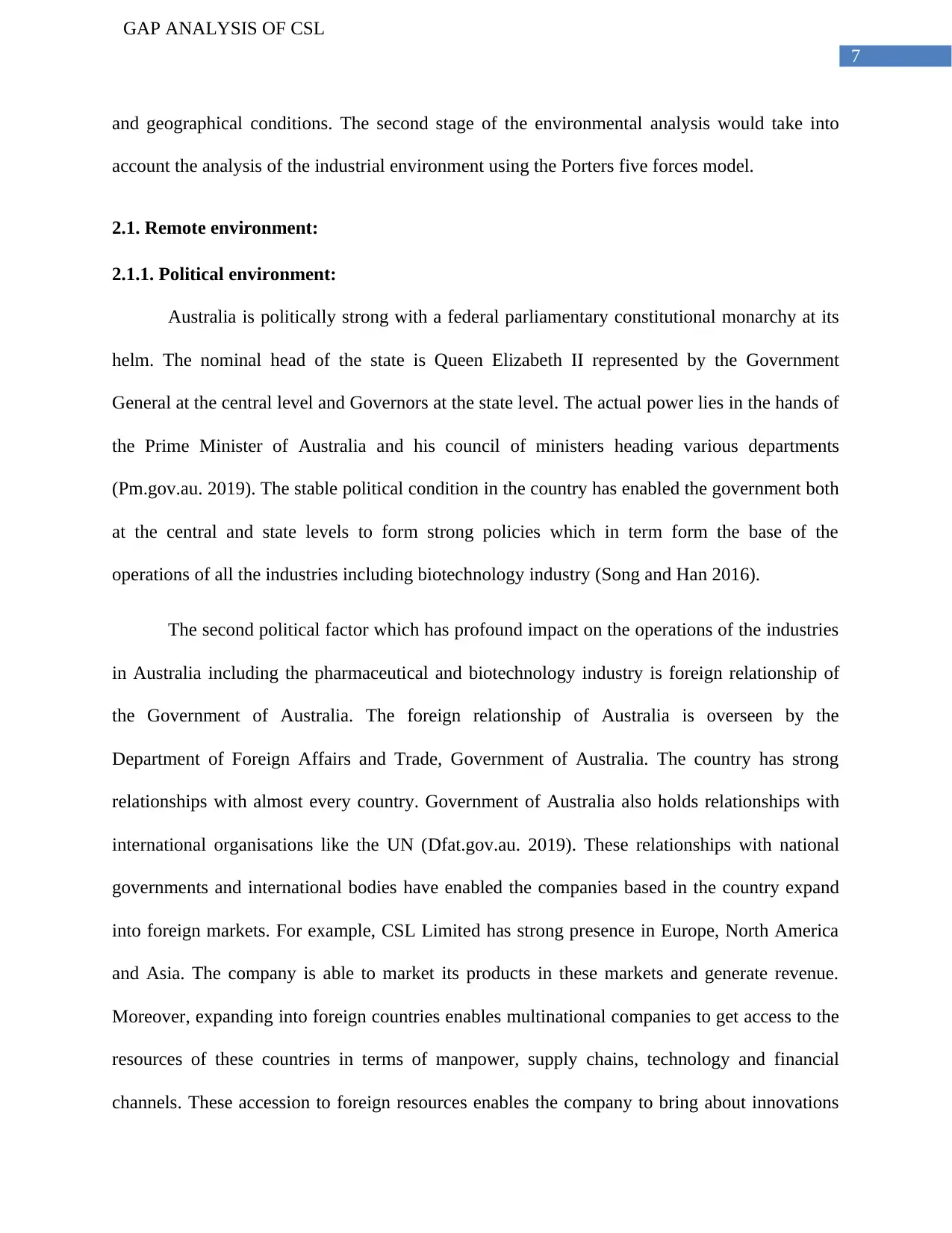
7
GAP ANALYSIS OF CSL
and geographical conditions. The second stage of the environmental analysis would take into
account the analysis of the industrial environment using the Porters five forces model.
2.1. Remote environment:
2.1.1. Political environment:
Australia is politically strong with a federal parliamentary constitutional monarchy at its
helm. The nominal head of the state is Queen Elizabeth II represented by the Government
General at the central level and Governors at the state level. The actual power lies in the hands of
the Prime Minister of Australia and his council of ministers heading various departments
(Pm.gov.au. 2019). The stable political condition in the country has enabled the government both
at the central and state levels to form strong policies which in term form the base of the
operations of all the industries including biotechnology industry (Song and Han 2016).
The second political factor which has profound impact on the operations of the industries
in Australia including the pharmaceutical and biotechnology industry is foreign relationship of
the Government of Australia. The foreign relationship of Australia is overseen by the
Department of Foreign Affairs and Trade, Government of Australia. The country has strong
relationships with almost every country. Government of Australia also holds relationships with
international organisations like the UN (Dfat.gov.au. 2019). These relationships with national
governments and international bodies have enabled the companies based in the country expand
into foreign markets. For example, CSL Limited has strong presence in Europe, North America
and Asia. The company is able to market its products in these markets and generate revenue.
Moreover, expanding into foreign countries enables multinational companies to get access to the
resources of these countries in terms of manpower, supply chains, technology and financial
channels. These accession to foreign resources enables the company to bring about innovations
GAP ANALYSIS OF CSL
and geographical conditions. The second stage of the environmental analysis would take into
account the analysis of the industrial environment using the Porters five forces model.
2.1. Remote environment:
2.1.1. Political environment:
Australia is politically strong with a federal parliamentary constitutional monarchy at its
helm. The nominal head of the state is Queen Elizabeth II represented by the Government
General at the central level and Governors at the state level. The actual power lies in the hands of
the Prime Minister of Australia and his council of ministers heading various departments
(Pm.gov.au. 2019). The stable political condition in the country has enabled the government both
at the central and state levels to form strong policies which in term form the base of the
operations of all the industries including biotechnology industry (Song and Han 2016).
The second political factor which has profound impact on the operations of the industries
in Australia including the pharmaceutical and biotechnology industry is foreign relationship of
the Government of Australia. The foreign relationship of Australia is overseen by the
Department of Foreign Affairs and Trade, Government of Australia. The country has strong
relationships with almost every country. Government of Australia also holds relationships with
international organisations like the UN (Dfat.gov.au. 2019). These relationships with national
governments and international bodies have enabled the companies based in the country expand
into foreign markets. For example, CSL Limited has strong presence in Europe, North America
and Asia. The company is able to market its products in these markets and generate revenue.
Moreover, expanding into foreign countries enables multinational companies to get access to the
resources of these countries in terms of manpower, supply chains, technology and financial
channels. These accession to foreign resources enables the company to bring about innovations
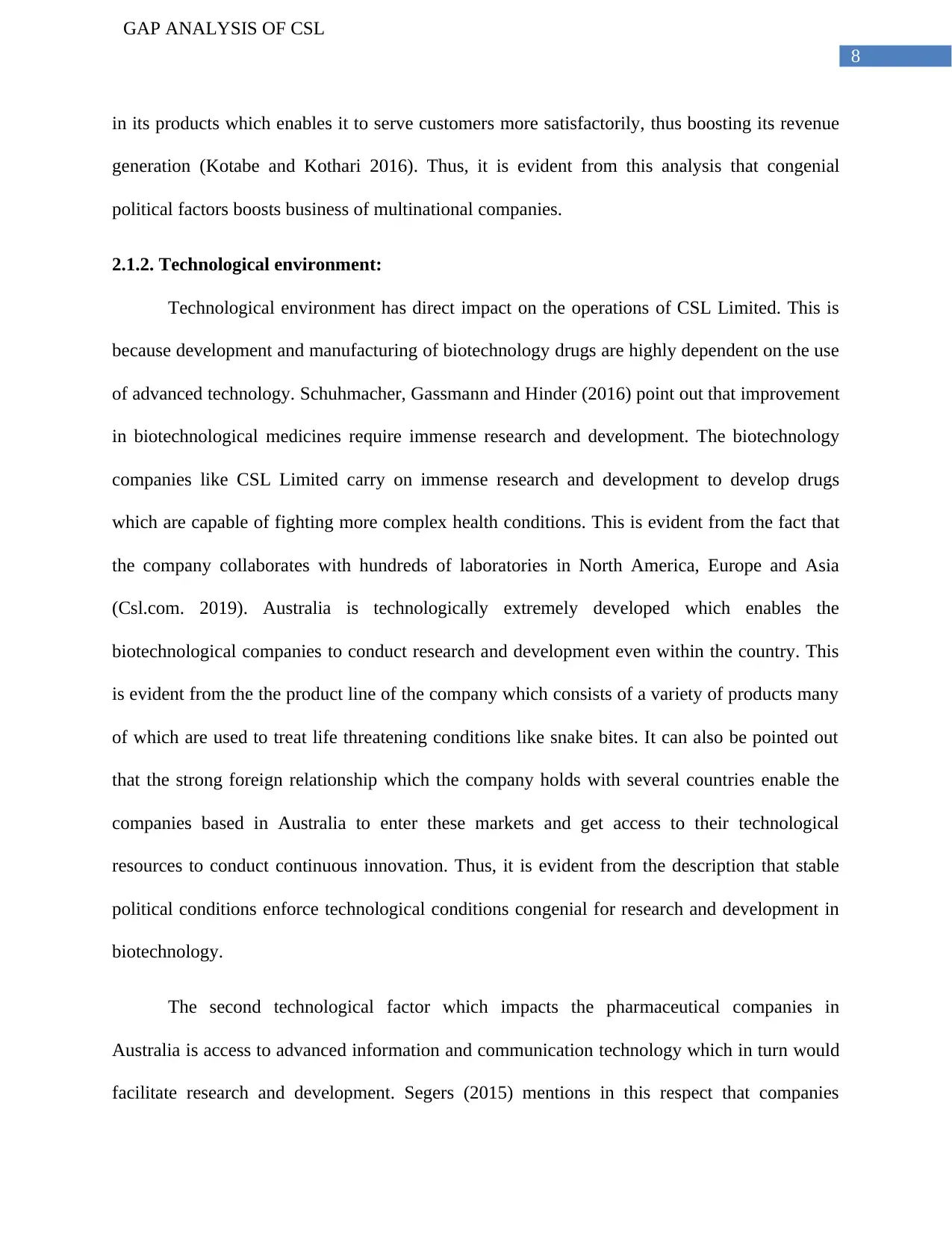
8
GAP ANALYSIS OF CSL
in its products which enables it to serve customers more satisfactorily, thus boosting its revenue
generation (Kotabe and Kothari 2016). Thus, it is evident from this analysis that congenial
political factors boosts business of multinational companies.
2.1.2. Technological environment:
Technological environment has direct impact on the operations of CSL Limited. This is
because development and manufacturing of biotechnology drugs are highly dependent on the use
of advanced technology. Schuhmacher, Gassmann and Hinder (2016) point out that improvement
in biotechnological medicines require immense research and development. The biotechnology
companies like CSL Limited carry on immense research and development to develop drugs
which are capable of fighting more complex health conditions. This is evident from the fact that
the company collaborates with hundreds of laboratories in North America, Europe and Asia
(Csl.com. 2019). Australia is technologically extremely developed which enables the
biotechnological companies to conduct research and development even within the country. This
is evident from the the product line of the company which consists of a variety of products many
of which are used to treat life threatening conditions like snake bites. It can also be pointed out
that the strong foreign relationship which the company holds with several countries enable the
companies based in Australia to enter these markets and get access to their technological
resources to conduct continuous innovation. Thus, it is evident from the description that stable
political conditions enforce technological conditions congenial for research and development in
biotechnology.
The second technological factor which impacts the pharmaceutical companies in
Australia is access to advanced information and communication technology which in turn would
facilitate research and development. Segers (2015) mentions in this respect that companies
GAP ANALYSIS OF CSL
in its products which enables it to serve customers more satisfactorily, thus boosting its revenue
generation (Kotabe and Kothari 2016). Thus, it is evident from this analysis that congenial
political factors boosts business of multinational companies.
2.1.2. Technological environment:
Technological environment has direct impact on the operations of CSL Limited. This is
because development and manufacturing of biotechnology drugs are highly dependent on the use
of advanced technology. Schuhmacher, Gassmann and Hinder (2016) point out that improvement
in biotechnological medicines require immense research and development. The biotechnology
companies like CSL Limited carry on immense research and development to develop drugs
which are capable of fighting more complex health conditions. This is evident from the fact that
the company collaborates with hundreds of laboratories in North America, Europe and Asia
(Csl.com. 2019). Australia is technologically extremely developed which enables the
biotechnological companies to conduct research and development even within the country. This
is evident from the the product line of the company which consists of a variety of products many
of which are used to treat life threatening conditions like snake bites. It can also be pointed out
that the strong foreign relationship which the company holds with several countries enable the
companies based in Australia to enter these markets and get access to their technological
resources to conduct continuous innovation. Thus, it is evident from the description that stable
political conditions enforce technological conditions congenial for research and development in
biotechnology.
The second technological factor which impacts the pharmaceutical companies in
Australia is access to advanced information and communication technology which in turn would
facilitate research and development. Segers (2015) mentions in this respect that companies
⊘ This is a preview!⊘
Do you want full access?
Subscribe today to unlock all pages.

Trusted by 1+ million students worldwide

9
GAP ANALYSIS OF CSL
involved in biotechnology and pharmaceutical researches require to collaborate with immense
numbers of firms operating in different countries. In this case the level of ICT development
available in their home countries has strong impact on their research and development (Ni et al.
2017). As far as Australia is concerned, the country owing to its strong economic conditions is
already strategically important markets to multinational ICT companies like Apple, Microsoft
and Vodafone. These multinational ICT companies provide the biotechnology companies in
Australia strong digital communication networks to exchange information with their business
partners like laboratories located both within and overseas. This availability of technology based
communication channel has enabled the biotechnology companies to acquire, share and manage
immense data which in turn finds use in their innovation (Michelino et al., 2015).
The third technological factor which has strong impacts on the biotechnology companies
in Australia is data theft. Segers (2015) can be reiterated in this respect to point out that
technological firms require to collaborate with several pharmaceutical companies and
laboratories to carry out open innovation which in turn require these firms to acquire, share and
use immense data among themselves. Arpaci (2017) points out in this respect that firms require
to make immense amount of data available on the digital platforms for their partners to use in
their respective R&D. Khidzir et al.(2016) point out that this availability of immense amount of
sensitive data on the digital space often attracts data theft risks initiated by illegal groups. Data
thefts often result in companies losing sensitive data, suffering heavy losses. As far as Australia
is concerned, the companies in the country including CSL owing to the profitability have
attracted data theft risks. This means that CSL Limited would be required to strengthen its data
security and usage parameters to counteract this threat of data theft.
GAP ANALYSIS OF CSL
involved in biotechnology and pharmaceutical researches require to collaborate with immense
numbers of firms operating in different countries. In this case the level of ICT development
available in their home countries has strong impact on their research and development (Ni et al.
2017). As far as Australia is concerned, the country owing to its strong economic conditions is
already strategically important markets to multinational ICT companies like Apple, Microsoft
and Vodafone. These multinational ICT companies provide the biotechnology companies in
Australia strong digital communication networks to exchange information with their business
partners like laboratories located both within and overseas. This availability of technology based
communication channel has enabled the biotechnology companies to acquire, share and manage
immense data which in turn finds use in their innovation (Michelino et al., 2015).
The third technological factor which has strong impacts on the biotechnology companies
in Australia is data theft. Segers (2015) can be reiterated in this respect to point out that
technological firms require to collaborate with several pharmaceutical companies and
laboratories to carry out open innovation which in turn require these firms to acquire, share and
use immense data among themselves. Arpaci (2017) points out in this respect that firms require
to make immense amount of data available on the digital platforms for their partners to use in
their respective R&D. Khidzir et al.(2016) point out that this availability of immense amount of
sensitive data on the digital space often attracts data theft risks initiated by illegal groups. Data
thefts often result in companies losing sensitive data, suffering heavy losses. As far as Australia
is concerned, the companies in the country including CSL owing to the profitability have
attracted data theft risks. This means that CSL Limited would be required to strengthen its data
security and usage parameters to counteract this threat of data theft.
Paraphrase This Document
Need a fresh take? Get an instant paraphrase of this document with our AI Paraphraser

10
GAP ANALYSIS OF CSL
2.1.3. Legal environment:
The legal environment in Australia has strong impacts on the biotechnology and
pharmaceutical companies like CSL Limited. The judicial system of the country functions with
the High Court of Australia Australia as its helm with federal courts acting as judicial authorities
at the state level. The firms in Australia have to comply with the laws and policies formed by the
government bodies and the courts. For example, the pharmaceutical companies operating in
Australia have to comply with the policies and directives of Department of Health, Government
of Australia (Health.gov.au. 2019).
The second legal aspect which comes into play during the functioning of biotechnology
companies like CSL is intellectual property laws. As far as Australia is concerned, the
intellectual properties which business organisations in the country possess comes within the
purview of IP Australia, Government of Australia (Ipaustralia.gov.au. 2019). Bhat (2017)
mentions in this respect pharmaceutical companies acquire intellectual property rights in the
forms of patents and trademarks for their innovation in order to prevent other firms from utilising
their inventions and discoveries. This enables the pharmaceutical companies owning the IPRs
derive long term benefits by marketing products whose IPRs they possess in the market to
generate profits. Dutfield (2017) in this respect mentions that IPRs found importance in the
financial accounting as well. Business organisations show intangible assets which include IPRs
in their balance sheets under non-current assets. This is evident from the excerpt of balance sheet
of CSL Limited shown below. The balance sheet shows as on 2017, the company had intangible
assets worth USD 1055.4 mn which increased to USD 1802.5 mn in the 2018. Thus, it is evident
that legal protection enables the company under study, CSL Limited uses the IPR laws in
Australia to acquire and manage IPRs of immense values.
GAP ANALYSIS OF CSL
2.1.3. Legal environment:
The legal environment in Australia has strong impacts on the biotechnology and
pharmaceutical companies like CSL Limited. The judicial system of the country functions with
the High Court of Australia Australia as its helm with federal courts acting as judicial authorities
at the state level. The firms in Australia have to comply with the laws and policies formed by the
government bodies and the courts. For example, the pharmaceutical companies operating in
Australia have to comply with the policies and directives of Department of Health, Government
of Australia (Health.gov.au. 2019).
The second legal aspect which comes into play during the functioning of biotechnology
companies like CSL is intellectual property laws. As far as Australia is concerned, the
intellectual properties which business organisations in the country possess comes within the
purview of IP Australia, Government of Australia (Ipaustralia.gov.au. 2019). Bhat (2017)
mentions in this respect pharmaceutical companies acquire intellectual property rights in the
forms of patents and trademarks for their innovation in order to prevent other firms from utilising
their inventions and discoveries. This enables the pharmaceutical companies owning the IPRs
derive long term benefits by marketing products whose IPRs they possess in the market to
generate profits. Dutfield (2017) in this respect mentions that IPRs found importance in the
financial accounting as well. Business organisations show intangible assets which include IPRs
in their balance sheets under non-current assets. This is evident from the excerpt of balance sheet
of CSL Limited shown below. The balance sheet shows as on 2017, the company had intangible
assets worth USD 1055.4 mn which increased to USD 1802.5 mn in the 2018. Thus, it is evident
that legal protection enables the company under study, CSL Limited uses the IPR laws in
Australia to acquire and manage IPRs of immense values.
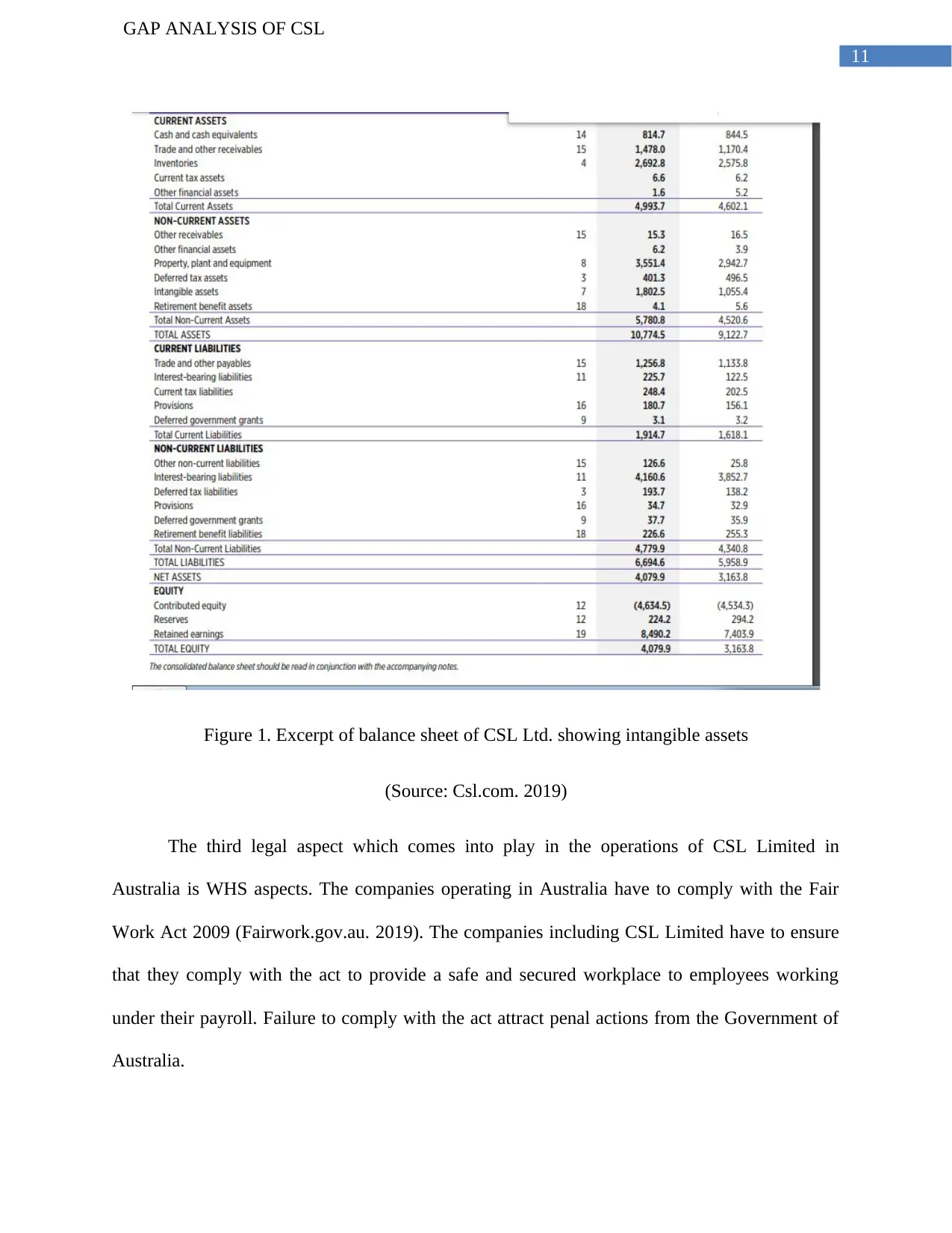
11
GAP ANALYSIS OF CSL
Figure 1. Excerpt of balance sheet of CSL Ltd. showing intangible assets
(Source: Csl.com. 2019)
The third legal aspect which comes into play in the operations of CSL Limited in
Australia is WHS aspects. The companies operating in Australia have to comply with the Fair
Work Act 2009 (Fairwork.gov.au. 2019). The companies including CSL Limited have to ensure
that they comply with the act to provide a safe and secured workplace to employees working
under their payroll. Failure to comply with the act attract penal actions from the Government of
Australia.
GAP ANALYSIS OF CSL
Figure 1. Excerpt of balance sheet of CSL Ltd. showing intangible assets
(Source: Csl.com. 2019)
The third legal aspect which comes into play in the operations of CSL Limited in
Australia is WHS aspects. The companies operating in Australia have to comply with the Fair
Work Act 2009 (Fairwork.gov.au. 2019). The companies including CSL Limited have to ensure
that they comply with the act to provide a safe and secured workplace to employees working
under their payroll. Failure to comply with the act attract penal actions from the Government of
Australia.
⊘ This is a preview!⊘
Do you want full access?
Subscribe today to unlock all pages.

Trusted by 1+ million students worldwide
1 out of 28
Related Documents
Your All-in-One AI-Powered Toolkit for Academic Success.
+13062052269
info@desklib.com
Available 24*7 on WhatsApp / Email
![[object Object]](/_next/static/media/star-bottom.7253800d.svg)
Unlock your academic potential
Copyright © 2020–2025 A2Z Services. All Rights Reserved. Developed and managed by ZUCOL.





